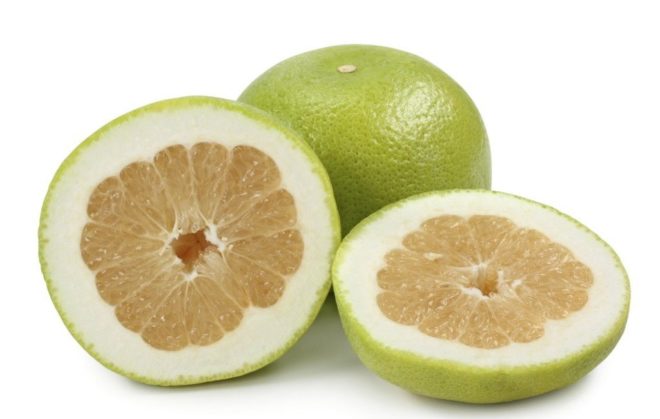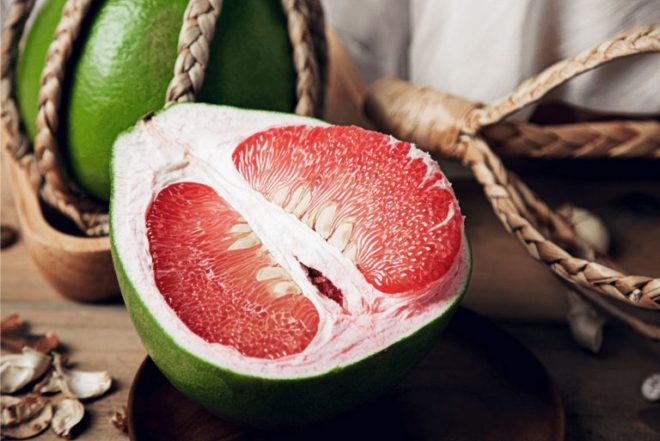Content
An exotic citrus called "pamela" appeared in our country relatively recently, but quickly gained popularity and love. This is a relative of the familiar to us oranges, tangerines and lemons. There are legends about the beneficial effects of culture on the human body. What is citrus actually, what are the benefits and harms of pamela? Let's figure it out.

Pamelo - a description of where and how the fruit grows
The exotic fruit called "pomelo" or "pamela" or "sheddog" belongs to the citrus family. This is a roundish fruit of a yellow-green color, and quite large: it can weigh 2-3 kg, but there is also a pomelo weighing 10 kg.
The culture is a large tree (it can reach 10 meters in height). The plant blooms with large white flowers, ripens from August to November.

The homeland of the culture is the Pacific Islands and China. The pomelo was brought to Europe by the English navigator Sheddock, in whose honor the name of the fruit was fixed in some countries. In China, the plant is very popular, the pomelo is presented as a gift for the New Year, culture is a symbol of wealth and good luck.
The pamela fruit looks like a grapefruit, only in large sizes.
There are different varieties of this culture. Depending on the variety, the fruits differ from each other in shape and color. They can be round, flattened, pear-shaped. Inside, citrus is yellow, greenish, white and pink. Pamela fruit tastes like an orange.
Now the plant is cultivated on an industrial scale in many countries and regions.
Chemical composition and calorie content
Low calorie citrus. This explains its popularity in weight loss diets. 100 g of the product contains only 35 kcal. But for its nutritional properties, the culture is very valuable. Only 300-400 g of aromatic and tasty pulp can saturate a person, without any additional dishes.
Citrus contains large amounts of calcium and potassium, sodium and phosphorus, as well as iron. It contains valuable B vitamins, as well as A and C.

The benefits of pamela for the human body
Such an exotic fruit from the citrus family has a beneficial effect on the human body. Its benefits are really great.
The tasty product contains many vitamins, essential oils and trace elements that have a positive effect on human health:
- A huge amount of vitamin C helps to quickly and effectively cope with any cold.
- The presence of vitamin A and antioxidants helps to prevent the division of cancer cells, stop the growth of tumor diseases.
- Microelements prevent the aging of the body.
- Enzymes are excellent at breaking down fats and proteins, which prevents obesity and activates digestion.
You can learn about the benefits of culture from the video:
Citrus, when consumed regularly, has a beneficial effect on the heart and blood vessels.
Culture improves physical activity, performance and endurance. Therefore, it is also very popular with athletes.
The fruit increases hemoglobin and is a natural antibiotic.
Particular attention is paid to the question of the benefits and harms of culture in diabetes. Pomelo lowers blood sugar levels, so it is recommended to use it for diabetes. In this case, the potential harm lies only in a possible allergic reaction of the body.
Citrus improves vision and lowers blood pressure.
For women and men
The fruit is good for both women and men. It stops the aging process in the body, effectively cleanses the intestines and helps to activate the body's defenses.
So there are people who got rid of such a disease after a 3-year pamelo diet.

Pomelo is actively used in the treatment and prevention of atherosclerosis.
Pamela improves blood circulation, which is an excellent prevention of prostatitis in men.
For pregnant women and breastfeeding
The benefits of pamela for pregnant women are undeniable. Vitamins and trace elements in citrus contribute to the full development of the unborn child and the normal course of pregnancy in general.
Like all of its citrus cousins, the pomelo is a fairly strong allergen.
Slimming
Women especially appreciate the pomelo for its low calorie content. Pamela is an essential ingredient in a variety of weight loss diets. The pamela diet will help you lose weight and will not deplete the body at the same time, but, on the contrary, will saturate it with useful substances.

How to eat pomelo fruit
Pomelo is consumed raw. To do this, you need to peel it from the top rind, divide it into slices and enjoy the aroma and sweet taste with a pleasant bitterness. The veins also need to be eaten, they are very useful and effectively cleanse the body of toxins.
Fruit application
Pamela is used not only in all kinds of diets, but also simply for a healthy diet, in folk medicine and in cosmetology.
Use in traditional medicine

For our latitudes, the pomelo is still considered an exotic fruit. Therefore, in folk medicine, its use is not yet so popular. But still, some traditional healers recommend using such a fruit for burns, for diseases of the gastrointestinal tract, for colds, with a strong cough.
In cooking
Even the thick rind of the pomelo is used in cooking. It is used to make candied fruit and sweets, as well as added to soups and side dishes as a natural flavoring.
At home, you can brew aromatic and healthy tea from the dried pamela peel.
The fruit is directly added to various salads. Pomelo also produces delicious and healthy freshly squeezed juice.
In cosmetology
For cosmetic purposes, the pulp of the fruit, and its peel, and even the leaves of the plant are actively used.
The pamela peel contains a lot of bioflavonoids and vitamin C. In the complex, these beneficial substances prevent the destruction of hyaluronic acid in the skin. It is this acid that is responsible for the youth and beauty of the skin. Therefore, the peel of the culture is actively used both in professional beauty salons and at home. A variety of face masks are made from it.
In the winter cold, it is very useful to wipe the face with citrus slices. Pomelo juice will help to tighten the oval of the face.
Harm and contraindications of pomelo
The harm from such a fruit is minimal.The use of the product is contraindicated only in some cases:
- Individual intolerance to citrus fruits, in which an allergic reaction on the skin is possible. This reaction is manifested by itching and hives.
- Significantly increased acidity of the stomach.
- Nephritis and hepatitis in acute form.
- Acute form of gastrointestinal diseases: ulcer, pancreatitis, colitis.
- Taking some medicines. Pamela can either enhance or weaken the effect of medications.
How to choose and store a pamela
Choosing a product is difficult. It's just that it's hard to determine its ripeness by eye. It is important to pay attention to the peel. A ripe fruit has a slightly glossy peel, no spots, cracks, or damage.
Particular attention should be paid to the citrus aroma. The stronger the aroma, the more ripe and tastier the fruit.
Keeping citrus is also easy. Pamela stays fresh for two weeks even without a refrigerator. The peeled fruit is stored in the refrigerator for 2-3 days.
Conclusion
An exotic fruit is indeed a whole storehouse of useful substances for humans. It is recommended to use it for many diseases, as well as to activate immunity and high-quality weight loss. The minimum of contraindications makes citrus suitable for consumption by both adults and children.

